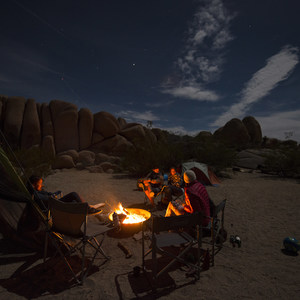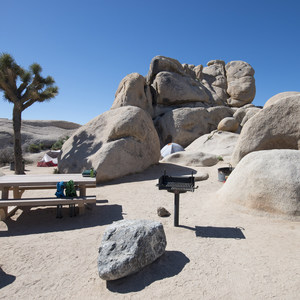Lucky Boy Loop is a scenic 3.4-mile loop hike in Joshua Tree National Park, offering an easy to moderate adventure through the desert with a total elevation gain of just below 200 feet. This hike showcases a variety of desert vegetation, intriguing rock formations, historical remains, and excellent wildlife viewing opportunities.
DESCRIPTION
The loop begins at the Pine City parking lot, located off Queen Mine Road, and winds through a landscape rich in pinyon pines, scrub, and cacti. Early on, you’ll pass vista points with sweeping views of the desert, followed by rocky outcrops that are perfect for exploring. As you continue, you'll come across the remains of Elton Mine, a historic feature that adds a fascinating element to the hike.
The final section of the loop runs for 0.5 miles along Desert Queen Mine Road, a dirt road leading back to the parking lot. Be mindful of passing vehicles on this stretch.
FLORA AND FAUNA
This area is home to various birds including scrub jays fluttering in the pinyon pines. It is also home to lizards, cottontails, and If you’re lucky, you might even spot a desert tortoise! The area also features a wide variety of desert plants, including:
-
Creosote Bush: One of the most common desert shrubs.
-
Cholla Cactus: Also known as the "jumping cholla," this cactus is easily recognizable by its spiny segments.
-
Ocotillo: A tall, spindly desert shrub that produces bright red flowers during the spring bloom.
-
Mojave Yucca: A signature desert plant with sharp, pointy leaves that can grow into large clusters.
-
Beavertail Cactus: A type of prickly pear cactus with flat, oval pads and bright pink flowers.
-
Desert Marigold: A vibrant yellow wildflower that blooms in the spring and adds color to the desert landscape.
The spring bloom is especially colorful, with many of these species flowering in bright reds, yellows, and pinks.
TERRAIN
The trail features a combination of sandy desert terrain, rocky sections, and gentle climbs, making it accessible to most hikers. However, the desert environment is exposed, there is no reliable water and shade is minimal.
WHEN TO VISIT
This trail is best hiked in the cooler months of fall, winter, and spring. It is not recommended during the summer due to high temperatures and lack of shade. Be sure to bring plenty of water, food, and sun protection.
SAFETY AND CONSIDERATIONS
-
No shade: The trail is exposed, so bring sunscreen, wear a hat, and pack plenty of water.
-
No water sources: Be self-sufficient with water, especially in hotter months.
-
Wildlife: Respect the wildlife, and if you encounter a desert tortoise, observe from a distance.
PARKING AND TRAILHEAD INFORMATION
The loop starts and ends at the Pine City parking lot, which offers parking for hikers accessing this and other nearby trails. Bathroom facilities are also available at the trailhead.























Comments
Sign In and share them.